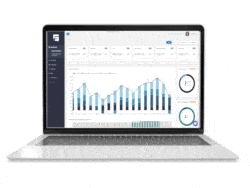Are you using QuickBooks to its fullest in your commercial real estate business? QuickBooks offers powerful tools to support your accounting and financial needs, making it a favorite platform for small and medium-sized businesses. But it’s easy to make mistakes in your QuickBooks use that turn key processes and workflows into logistical nightmares.
At STRATAFOLIO, we frequently see the same process issues in QuickBooks that make things harder for our clients. Here, we’ll explore these common problems and how you can resolve them for faster and more accurate workflows, letting you focus on growth instead of busywork.
Common Area Maintenance
Issue: Triple-Net Expenses and Income Recorded Incorrectly
Remember that expenses for triple-net (NNN) costs are still expenses. Even though your tenants will reimburse you for these costs, you still need to account for them. Incorrectly recording the expenses and eventual income from NNN leases makes it impossible to perform accurate common area maintenance (CAM) reconciliations.
You will also lack sufficient information to make more accurate CAM estimates in the upcoming years. This could potentially lead to higher expenses for both you and your tenants.
Solution: Include Triple-Net Costs as Expenses
Initially, NNN costs that you incur should be recorded as expenses and not income. At the end of the year, reconcile by comparing the actual expenses to the amount collected from tenants for the year. Then, reimburse or invoice tenants for the difference.
On the other hand, CAM charges collected from tenants should be posted to an Income account. These are invoiced to the tenants based on your projected budget for the year. To see the amount collected for taxes, insurance, and CAM separately, create additional income accounts for each category. This way, you can perform an accurate, specific analysis of your income.
Reimbursable Accounts
Issue: No Separation between Reimbursable and Non-Reimbursable Expense Accounts
Not separating these expense types is a common process issue in QuickBooks that can lead to confusion and extra work down the road. You’ll have difficulty ensuring that you charge tenants the correct amount for CAM charges and accurately reconciling at the end of the year. Plus, you won’t easily be able to see where your money is going, preventing you from making smart budget adjustments.
Solution: Include Both Types of Expenses in Your Chart of Accounts
We highly recommend setting up the chart of accounts to include reimbursable and non-reimbursable expense accounts, keeping the two separate. Expenses posted to the reimbursable accounts are CAM or operating expenses that you will pass on to your tenants. Expenses posted to the non-reimbursable expense accounts are those that the tenant will not be sharing as part of their NNN fees.
This approach will save you time and effort at year-end on CAM reconciliations. Posting the expense to the proper account when you pay it is much easier than trying to remember what the expense was for at the end of the year. The clarity of this method also means that anyone can run reports and calculations and reach the exact same result, every time.
Invoicing
Issue: Forgotten, Recurring, or Rare Invoicing
While it can be tempting to set up invoices far in advance, like creating them for an entire year at the beginning of the year, this approach is likely to cause problems in the long run. Invoicing ahead of time changes depending on whether you use cash or accrual-based accounting. Also, when you don’t check invoices regularly, it’s easy not to notice escalations, errors, or even missed payments.
Similarly, it may be tempting not to invoice at all. Many owners assume that because payment information is in the lease, tenants always pay the right amount at the right time. However, this leads to confusion, mistakes, and missed or incomplete payments with no way to verify what a payment collected is for. Tenants lack frequent, clear reminders of their financial obligations when they do not receive invoices.
Solution: Update, Separate, and Verify Invoices
To avoid confusion, invoice tenants monthly and create invoices for only one month at a time. This gives you more control in case anything changes throughout the year. It also serves as a reminder to check payments regularly and to verify that tenants are paying the full amount monthly.
Finally, if you’ve created invoices too far in advance, you can run into issues when you perform CAM reconciliation. If you discover you need to make budget adjustments for next year, you’ll have to change your invoices. It’s extra, unnecessary work to change invoices after the fact.
Also, it’s a good idea to create different “customers” when you have one tenant occupying multiple units in other buildings. Especially if your tenants are chains, this keeps the invoices for each unit separate, providing clarity for both you and the tenant.
Avoiding Common Process Issues: A Quick Guide
| Category | Issue | Solution |
|---|---|---|
| Common Area Maintenance | Triple-Net Expenses and Income Recorded Incorrectly: – Not recording NNN costs as expenses – Causes difficulty with CAM reconciliation and budget adjustments | Include Triple-Net Costs in Expenses: – Remember NNN costs are expenses – Sort tenant payments for NNN costs into Income – Separate CAM, tax, and insurance income into individual accounts for extra clarity |
| Reimbursable Accounts | Reimbursable Accounts Not Separated: – Lack of visibility into expenses – Makes accurate invoicing and CAM reconciliation difficult | Include Both Types of Expenses in Your Chart of Accounts: – Create separate accounts for reimbursable and non-reimbursable expenses |
| Invoicing | Forgotten or Rare Invoicing: – Setting up invoices in advance can lead to errors and extra work – Not sending invoices leads to missed or incomplete payments | Update, Separate, and Verify Invoices: – Create invoices monthly to stay on top of budget adjustments – Verify that tenants pay the whole amount each month – Create multiple customers for tenants leasing space in multiple buildings for extra clarity |
Discover how STRATAFOLIO Can Streamline Your Accounting Processes
If you’re ready to improve your process issues in QuickBooks and streamline your accounting, you’re not alone. STRATAFOLIO is here to help you learn how to set up your QuickBooks and leverage important tools for the best results.
Looking for maximum functionality? STRATAFOLIO integrates with QuickBooks to provide a complete accounting and property management system specifically designed with commercial real estate needs in mind. Take advantage of automations for time-consuming tasks like 1-click CAM reconciliation and reminders for key dates like lease escalations. A user-friendly interface that makes it easy to find the information you need.
For more information on how STRATAFOLIO can improve accounting for commercial real estate businesses, schedule a 1:1 demo now.






